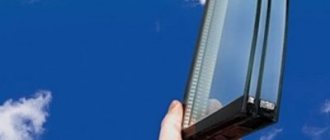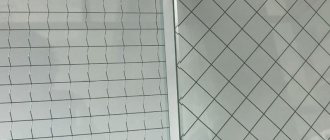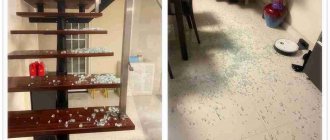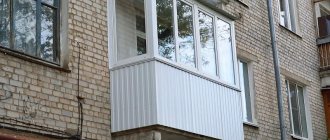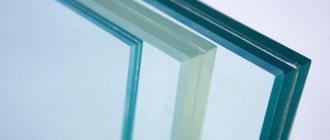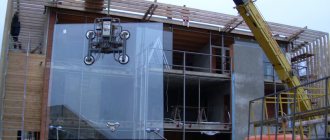Solar control glass unit
Solar control glass unit is a design that uses glass with sun protection properties. The function of solar control glass is to protect the room from various types of solar radiation by reflection and/or absorption with further dissipation of energy.
The solar protection qualities of glass are ensured in three main ways, each of which has its own advantages and areas of application:
- bulk tinted glass. They are made during the float glass production process by adding tinting additives from metal oxides to the melt. The degree of transparency of glass colored in the mass depends on its color and thickness. Glass tinted in bulk has a high degree of heat absorption. To reduce absorption and increase reflective properties, selective coatings based on metals or metal oxides are applied to glass colored in the mass.
- glass with magnetron sputtering of selective layers. Magnetron (“soft”) coating is applied to finished transparent or colored glass and has the most effective protective properties. Depending on the type of coating, the glass can be tinted, with a mirror effect, or transparent with the ability to selectively retain thermal radiation. Selective glass with a “soft” coating is used in double-glazed windows to preserve the coating.
- glass with pyrolytic (“hard”) coating of selective layers. It is applied to transparent or colored glass during its production during the cooling phase of the melt. Pyrolytic coating is more durable than magnetron coating and can be used in single glazing. Protective properties also depend on the type of metal or metal oxide coating.
The spectrum of solar energy consists of electromagnetic waves with different lengths:
- Gamma rays, X-rays and short ultraviolet (UV-C) radiation up to 280 nm are blocked by the earth's atmosphere.
- 280-380 nm - ultraviolet (UV-B, UV-A) radiation reaching the earth's surface. Provides about 5% of all incoming energy. In everyday life, it affects the photosynthesis of plants and negatively affects various materials in the room. The purpose of protective glazing is to reduce the amount of UV-B and UV-A entering the room.
- 380-780 nm - visible light. About 50% of all energy. Determines the illumination of the room. The purpose of solar control glazing is to reduce brightness.
- 780-2480 nm - short (IR-A) and medium (IR-B) waves of infrared radiation. About 45% of all energy. Provide heating of objects directly from the sun. The purpose of solar control glazing is to reduce heating of the room from direct sunlight. The spectral range of radiation from 280 to 2480 nm falling per unit surface directly from the sun is called directed solar energy .
- 2480 nm and more - long-wave (IR-C) infrared radiation. Undirected (scattered) solar energy obtained from radiation absorbed by the atmosphere. The purpose of solar control glazing is to reduce heating of the room from the air, surrounding objects, etc.
- reducing the impact of UV radiation on room interior items
- reducing room illumination
- reduction of room heating from direct solar radiation
- reduction of room heating from non-directional solar radiation
The less glass in a double-glazed window, the more light
Table 2 Number of glasses and light****
****GOST 24 866-99 Double-glazed windows for construction purposes, clause 4.1.7, Table 4 In a single-chamber double-glazed window there are 2 glasses, which means the amount of light from the total luminous flux will pass through such a structure 80%. If we replace the double-glazed window with a double-chamber one, i.e. of three glasses – the light will decrease by 8%. Please note that the indicators “Heat transfer resistance” (the higher, the warmer the window) and “Sound insulation” (the higher, the quieter) for a double-chamber double-glazed window are higher by 27 and 7%, respectively. It is not recommended to install windows with standard single-chamber double-glazed windows (aluminum spacers, ordinary glass) in heated rooms, such as apartments, school classrooms, etc.
The fewer bells and whistles in the glass (energy-saving, tinted, triplex, etc.) - the more light
Table 3 Glass shutters and light****
If one glass in a double-glazed window is energy-saving, then there will be less light by 5% if the double-glazed window is 2 glasses (single-chamber) and by 7% if the double-glazed window is 3 glasses (double-chamber).
At the same time, double-glazed windows with energy-saving glass are 60-80% warmer than standard ones (calculated by a simple proportion according to Table 3).
Those. in this case, the benefit from energy saving is much greater than the benefit from light.
Table 4 Type of glass unit and light*****
***** GOST 24 866-99 Double-glazed windows for construction purposes, Appendix A, Table A1
Light transmission coefficient of double-glazed windows
As can be seen from this table, the difference in the light transmittance of sheet glass of the same thickness can reach 9%, with double-layer glazing - 16%, with three-layer glazing - 21%. As already noted, coatings on glass reduce its light transmittance, therefore, in order to “keep” the overall transmittance of coated glass within acceptable limits and ensure standard glazing transmittances, coatings must be applied to glass with a high transmittance.
Main characteristics of double-glazed windows
Main characteristics of basic double-glazed windows. Specific weight, kg/m. sq. Heat transfer resistance, m. sq.* C 0 / W Reducing the noise level of urban transport, DbSPD 8( tr )-10-4-14-4 Weight of a double-glazed window = specific gravity of a double-glazed window * area of a double-glazed window. Specific gravity of a double-glazed window = the sum of the specific weights of the glasses that make up the double-glazed window; Specific gravity of glass is calculated based on the fact that 1 m 2 of glass with a thickness of 1 mm weighs 2.5 kg. When selecting a joint, in addition to the above characteristics, the following should be taken into account: Light transmission (LT) - transmission of the visible spectrum of solar radiation by the structure (radiation spectrum: 380. 780 nm), measured in percent (%). The higher the coefficient, the more rays of the visible spectrum pass through the SP. Visible light reflection (LR) is the reflection of the visible spectrum of solar radiation by the structure (radiation spectrum: 380. 780 nm), measured in percent (%). Solar factor (SF) - total transmission of solar energy. Direct passage of solar heat plus absorbed heat, then radiated into the room (radiation spectrum: 280 - 2500 nm), measured as a percentage (%). The lower the coefficient, the less amount of solar heat passing through SP will enter the room. Direct energy transmission - the percentage of solar energy directly passing through glass with a spectral density between 300 and 2150 nm (according to the EN 410 classification). Energy reflection - the percentage of solar energy reflected from the glass. Energy absorption - the amount luminous flux energy absorbed by the mass of glass, expressed as a percentage of the total amount of luminous flux energy incident on the glass surface. The absorbed energy is then radiated outside or inside the room in a ratio depending on the characteristics of the glazing, wind speed, internal air flow speed, air temperature outside and inside. Heat transfer coefficient (U-value) - the amount of heat in W per unit time that passes through 1 m2 glass surface, divided by the difference in degrees between the internal and external temperatures. Heat transfer coefficient (R-value) is the inverse value of the heat transfer coefficient, characterizing the property of glass to prevent the transfer of heat from an environment with a high temperature to an environment with a low temperature. The higher the heat transfer resistance value, the less the load on the building's heating system during the cold season. The dew point is the temperature at which condensation begins to form, i.e. the temperature to which the air must be cooled in order for the relative humidity to reach 100%. Optitherm S3 is variety of i-glass. Rw - weighted sound insulation index of airborne noise, measured in relation to the reference spectrum of white noise (noise with constant spectral density); Rw + C - sound insulation index of typical mid-frequency noise (yard noise); RW + Ctr - sound insulation index typical transport noise, measured in relation to the typical noise spectrum of vehicles (low-frequency noise) Indicators C and Ctr reduce the sound insulation index Rw. Noise-proof and anti-resonance double-glazed windows. Noise-proof double-glazed windows are those that provide sound insulation of at least 34 dB (regardless of the number of chambers). This effect is achieved by using thicker glass (for example, 6mm instead of 4mm), which dampens most of the noise. An additional measure in noise reduction is chambers of different thicknesses in multi-chamber packages. An anti-resonance double-glazed window is a double-glazed window, the design of which not only provides increased sound insulation, but also prevents the amplification (due to resonance) of external noise. The solution to this problem is to manufacture a double-glazed window with the arrangement of glass of different thicknesses at different distances between them. In the resulting design, both glass and chambers have different widths. Combinations of glass and chambers of various thicknesses reduce the resonance effect or prevent its occurrence. Since increasing the level of sound insulation requires an integrated approach, inert gases, such as Argon, are widely used to improve the acoustic properties of all double-glazed windows, including anti-resonance ones. Safe double-glazed windows are those that do not cause injuries or cuts when destroyed. This can be achieved in several ways: - using special films or glass glued together (triplex); When using films or glass glued together (triplex), when destroyed, the fragments do not fly apart, but remain on the film. When tempered glass breaks, it crumbles into small fragments having no cutting edges.Created with the Personal Edition of HelpNDoc: Free HTML Help documentation generator
Types of glass for double glazing
Sheet glass
Sheet glass is a basic product of the glass industry - it is colorless, transparent soda-lime-silicate glass, manufactured by float or vertical drawing methods without any additional surface treatment, in the form of flat rectangular sheets, the thickness of which is small in relation to the length and width.
Sheet glass can be unpolished or polished, colored or clear, however, it is never completely transparent: even the best optical glass transmits only 92–95% of light.
Modern technologies and equipment make it possible to produce many types of glass with different properties from sheet glass, for example:
• heat-saving (low-emissivity) glass, the use of which in the glazing of buildings allows reducing heat energy consumption;
• tempered glass (stalinite), which has 5 times greater strength than ordinary glass, incl. thermal. When tempered glass breaks, small fragments with blunt edges are formed, which can significantly reduce the risk of injury to people;
• laminated glass (including building and automotive triplex), when such glass breaks, the fragments do not fly apart, remaining held together by a polymer composition, i.e. safety glass;
• mirror cloth, glass capable of reflecting surrounding objects and visually enlarging the space;
• tinted glass, limiting the transmission of sunlight and ultraviolet radiation;
and many other types of glass and its derivatives.
Production technology
Modern glass production technology, called the float process, was proposed by the English inventor Alistair Pilkington in the mid-20th century. A characteristic feature of this method is that sheet glass is obtained by pouring heated glass melt onto a layer of molten metal. Glass production is based on several components, the main ones being quartz sand and sodium carbonate (soda). All components are mixed and heated to one and a half thousand degrees Celsius. After this, the resulting mass is cleaned, brought to a state of homogeneity and cooled to a thousand degrees.
Liquid glass is poured into a bath of molten tin, and the glass mass, due to its lower density, forms the top layer. The surface at the interface between two liquid media is almost flat, which makes it possible to almost completely eliminate optical distortions in the future sheet of glass. Hence the name, polished glass.
After the liquid glass is evenly distributed over the surface of the tin, it is gradually cooled until completely solidified. Then the resulting glass tape is cut into sheets of the required size and packaged in containers.
Heat-saving glass
Heat-saving (energy-saving) glass is polished glass that has a special low-emissivity coating made of metal oxides, which allows you to retain heat in the room. The coating freely transmits short-wave solar energy into the room, while at the same time reflects long-wave thermal radiation, for example from heating devices, into the room, preventing it from escaping outside. In the summer, the heat-saving coating reflects solar thermal energy from the outside, preventing heat from penetrating into the room. The coating is several hundred angstroms thick, has the properties of a light filter, is transparent to the human eye, visually glass with a heat-saving coating is no different from ordinary transparent glass. It is usually used as internal glass in double-glazed windows, with a coating inside the interglazed space. This heats the inner surface, which reduces condensation and convection caused by temperature differences. The use of low-emissivity glass significantly reduces heat loss, allowing you to save on space heating.
At the moment, two types of low-emission coatings have become widespread: “hard” (K-glass) and “soft” (E-glass).
"Hard" coating.
It is applied by the pyrolytic method to the hot surface of the glass at the time of its manufacture and forms a chemically and mechanically stable compound. Glass with a “hard” coating is called “K-glass.”
Advantages:
• resistance to mechanical and atmospheric influences;
• the ability to use outside the glass unit.
Flaws:
The coating is applied unevenly, which impairs the heat-saving characteristics of the glass.
"Soft" coating.
It is applied to polished glass using ion-plasma sputtering in a vacuum. Glass with a “soft” coating is called “Low E” (Pilkington), “Planibel Plus” (Glaverbel), “Planiterm Futur” (San Gobain).
Advantages:
high heat-saving characteristics of glass due to the uniform distribution of low-emissivity coating over the surface of the glass, therefore Low E-glass retains heat in the room better than K-glass. Flaws:
high production standards are required when working with Low E-glass; the soft coating can be easily damaged, therefore Low E-glass can only be used as part of double-glazed windows, and the glass must be coated with the inside of the double-glazed window.
A characteristic of heat conservation is the emissivity of glass (emission). The lower the emissivity, the less heat loss. The emissivity value of plain glass is 0.83, K-glass is 0.2, Low E-glass is from 0.04. Thus, Low E-glass in its heat-saving properties exceeds ordinary glass by 21 times, and K-glass by 5 times.
Tinted glass
Tinted glass is widely used in construction, both for external cladding of building facades and for interior decoration of premises, giving them a modern, original look. It protects from sunlight and limits the transmission of ultraviolet radiation into the room, protecting furniture and interior items from fading.
There are several technologies for producing tinted glass:
• mass tinting method; • tinting using pyrolysis method; • tinting using polymer films; • tinting by applying coatings in a vacuum.
Glass tinted in bulk.
Glass is colored at the time of its melting by adding a coloring component to the molten glass mass.
Advantages: • resistant to mechanical stress, which makes it convenient and easy to work with glass when processing it;
• subject to hardening. Flaws:
• glass is heat-absorbing and conducts thermal energy;
• the range of glass produced by Russian factories is extremely limited, and Western-made glass, although it has a wide variety of colors, is much more expensive than domestic glass.
Glass tinted by applying metals using pyrolysis.
During its production process, a thin layer of metals is applied to one of the surfaces of the glass, combining with the hot surface of the glass to form a chemically and mechanically stable compound.
Advantages:
• high wear resistance and durability;
• attractive reflective, mirror surface;
• ability to reflect thermal energy. Flaws:
high price.
Glass tinted using polymer films.
A colored polymer film is glued onto transparent polished glass.
Advantages:
• a wide range of films in colors, thickness and width;
• attractive appearance;
• when applying the film, the glass acquires the properties of safety glass (“duplex”);
• no expensive equipment is required to apply film to glass. Disadvantages: • high cost of films; • the film is subject to mechanical stress and can be damaged relatively easily.
Glass tinted by metal spraying in a vacuum.
A thin layer of metal oxides is applied to clear polished glass in a vacuum chamber, giving it a specific color and various properties.
Advantages:
• the coating is more resistant to mechanical and atmospheric influences than polymer film;
• high characteristics of reflection of light and thermal radiation;
• the ability, at the request of the client, to produce glass of any thickness, with any characteristics of light reflection and light transmission, which depend on the thickness of the layer of metals sprayed onto the glass (from several angstroms to several micrometers);
• possibility of coating patterned glass;
• high efficiency of order execution;
• relatively low cost compared to other technologies for producing tinted glass.
Disadvantages: • lack of choice of colors;
• impossibility of heat treatment and hardening.
Strained glass
Tempered sheet glass is glass of any composition, color, shape and size, subjected to special hardening by heating to 650–700ºC and then rapidly cooling. During the tempering process, the outer layers of glass come into a state of strong compression, and the inner layers into a state of tension, forming a system of stresses in the glass that ensures its high mechanical and thermal strength. When the limit of mechanical strength is reached, tempered sheet glass collapses, but crumbles into small rounded fragments that do not have sharp cutting edges.
The operations of cutting, drilling holes and processing the edges of glass sheets must precede tempering, since tempered glass is not subject to any mechanical processing.
Tempered glass is, first of all, safety glass. Safety is manifested precisely by the nature of the destruction of such glass. Small fragments of broken glass will not harm a person, even falling from great heights. In contrast to “raw”, which is damaged at the same thickness by less powerful mechanical impacts, and its large fragments are very dangerous for others. The strength of tempered glass exceeds the strength of raw glass by more than 5 times.
An important role in the use of tempered glass is played by another of its properties - resistance to sudden temperature changes “thermal shock”, which reaches about 200ºC, which is critical when using tinted and heat-absorbing glasses, the light transmittance of which is less than 70%.
Tempered glass has a wide range of applications, especially when parameters such as increased mechanical strength with relatively low weight, high heat resistance and safety in case of breakage are required. First of all, these are façade and structural glazing, the introduction of technologies in our country is gaining momentum, as well as in the manufacture of office partitions, glass doors, frameless balcony glazing, stained glass windows and fences.
Construction "triplex"
Construction triplex or multilayer safety glass is a product consisting of silicate glass plates bonded together with polyvinyl butyral film or a polymer composition. This type of glass is classified as safe: it is very difficult to break, and even if it breaks, the fragments do not fly apart, remaining glued to the film, which prevents injury to people.
By combining sheets of glass and layers of film, a very durable material is obtained that can withstand impacts, explosions and even gunshots. Construction triplex prevents immediate entry into the room: some of its varieties are no easier to destroy than breaking a brick wall. Such glass is used where it is necessary to ensure the safety of people and material assets: in banks, shop windows, museums, exhibition galleries. Construction triplex can be made from various tinted glasses, and can also be used in the manufacture of building double-glazed windows.
Using laminated glass, glass floors, ceilings and load-bearing walls can be made, giving architects another tool to create extraordinary buildings and interiors.
Design of double-glazed windows
Various types of double-glazed windows are inserted into plastic windows.
Double-glazed windows are volumetric products consisting of two or three sheets of glass connected to each other along the contour using spacer frames and sealants, forming hermetically sealed chambers filled with dried air or other gas.
Depending on the number of chambers, double-glazed windows are divided into types:
· SPO – single-chamber
· SPD – two-chamber
The chambers of double-glazed windows can be filled with:
- dry air
- inert gas (argon - Ar, krypton - Kr and others)
— sulfur hexafluoride (SF6)
It is allowed to make double-glazed windows from four or more sheets of glass, as well as install decorative frames inside the double-glazed windows.
Depending on their purpose, double-glazed windows are divided into types:
— double-glazed windows for general construction purposes;
— double-glazed windows for construction purposes with special properties : impact-resistant (UD), energy- (E), sun-protective (S), frost-resistant (M), noise-proof (SH).
It is recommended to make double-glazed windows with a thickness of 14 to 60 mm, the distance between the glasses from 8 to 36 mm. The dimensions of double-glazed windows in height and width, as a rule, should not exceed 3.2 x 3.0 m. It is not recommended to manufacture double-glazed windows with dimensions less than 200 x 300 mm, as well as with an aspect ratio of more than 5: 1.
The maximum area of a double-glazed window depends on the thickness of the glass and the distance between the glasses, and is determined from the tables.
Double-glazed windows of complex configuration (round, oval, triangular) are manufactured according to working drawings or templates.
The production of double-glazed windows consists of several operations: preparation, assembly of the double-glazed window, sealing and quality control.
Procurement operation.
This operation involves: cutting glass, washing glass, cutting the spacer frame, filling the desiccant (silica gel) inside the spacer frame, assembling the spacer circuit, applying the primary sealing layer (liquid butyl, butyl cord or butyl tape).
The operation of assembling a double-glazed window.
The assembled distance circuit is glued to the glass. Then the glass is installed on top. After this, the glass unit is crimped in order to achieve the maximum and required thickness of the structure.
Sealing operation.
During this operation, a secondary sealing layer (two-component, polysulfide sealant - theocol) is applied to the end of the assembled glass unit.
Quality control operation.
During this operation, on a special table with lighting, a visual control of the quality of the double-glazed window is carried out (there should be no dust inside the double-glazed window, the primary sealing layer should be continuous, there should be no leaks of sealant inside the remote contour). After this, the double-glazed windows are installed in a special chamber for drying.
Thermophysical characteristics of double-glazed windows
Double-glazed windows are subject to certain requirements in terms of quality, thermophysical, sound insulation and other characteristics.
· The glass surfaces in double-glazed windows must be clean; dirt and oil stains are not allowed.
· The sealant should not get inside the glass chamber.
· Double-glazed windows must be sealed.
· The main physical characteristics of double-glazed windows must meet the requirements specified in the table (GOST 24866-99)
| Type of glass unit | Type of glass package | Resistance - warmer - edition, not less, m² ºС /W | Coefficient directional transmission Sveta, not less, % | Sound – insulation, not less, dB | Dew point no higher than ºС | Protection class, no less |
| General construction purpose | Single chamber | 0,32 | 80 | 25 | Minus 45 | — |
| Double chamber | 0,44 | 72 | 27 | Minus 45 | — | |
| Impact-resistant cue | Single chamber | 0,32 | 74 | 26 | » | Al |
| Double chamber | 0,44 | 67 | 28 | » | Al | |
| Sun protection | Single chamber | 0,32 | — | 25 | » | — |
| Double chamber | 0,44 | — | 27 | » | — | |
| Energy saving barking | Single chamber | 0,58 | 75 | 26 | » | — |
| Double chamber | 0,72 | 65 | 28 | » | — | |
| Frost-resistant | Single chamber | 0,58 | 75 | 26 | Minus 55 | — |
| Double chamber | 0,72 | 65 | 28 | Minus 55 | — | |
| Noiseproof | Single chamber | 0,32 | 74 | 34 | Minus 45 | — |
| Double chamber | 0,44 | 67 | 34 | Minus 45 | — | |
| Note: To characterize solar-protective double-glazed windows, the total solar energy transmittance coefficient is used, which is established in the design documentation. | ||||||
Double-glazed windows must be durable (resistant to long-term cyclic climatic influences). The durability (reliability) of double-glazed windows must be at least 20 conventional years of operation.
The thermophysical characteristics of some double-glazed windows are shown in the table
| № | Type of glass unit | Thickness mm | Configuration | Gas accumulation | Energy saving glass | Heat transfer resistance m² * ºС/W |
| 1 | Single chamber | 24 | 4 – 16 — 4 | Air | — | 0,35 |
| 2 | Single chamber | 24 | 4 – 16 — 4 | Argon | — | 0,37 |
| 3 | Single chamber | 24 | 4 – 16 — 4 | Air | TO | 0,54 |
| 4 | Single chamber | 24 | 4 – 16 — 4 | Argon | TO | 0,59 |
| 5 | Double chamber | 28 | 4 – 8 – 4 – 8 — 4 | Air | — | 0,49 |
| 6 | Double chamber | 28 | 4 – 8 – 4 – 8 — 4 | Argon | — | 0,52 |
| 7 | Double chamber | 28 | 4 – 8 – 4 – 8 — 4 | Air | TO | 0,57 |
| 8 | Double chamber | 28 | 4 – 8 – 4 – 8 — 4 | Argon | TO | 0,63 |
| 9 | Double chamber | 30 | 4 – 8 – 4 – 10 — 4 | Air | — | 0,50 |
| 10 | Double chamber | 30 | 4 – 8 – 4 – 10 — 4 | Argon | — | 0,53 |
| 11 | Double chamber | 30 | 4 – 8 – 4 – 10 — 4 | Air | TO | 0,58 |
| 12 | Double chamber | 30 | 4 – 8 – 4 – 10 — 4 | Argon | TO | 0,64 |
The use of double-glazed windows with a heat transfer resistance lower than recommended can lead to the formation of condensation on the inner glass from the side of the room in winter. This happens because the double-glazed window seems to freeze, that is, the temperature on the inner glass becomes slightly lower than the air temperature in the room. There is always moisture in the air and at a certain temperature condensation forms on cold glass.
If the air temperature is 20ºС, the water content in the air is 8.65 g/m3 (50%), and the temperature on the glass is less than 9.3ºС, then condensation will form on it
Soundproofing characteristics of double-glazed windows.
Sound refers to mechanical vibrations and waves that propagate in gases, liquids and solids and are perceived by the human ear. The loudness of a sound is expressed by sound pressure and measured in dB.
Noise is random sound vibrations of different nature, characterized by random changes in amplitude and frequency. To protect against sound, it is necessary to dampen vibrations in the audible frequency range.
There are several ways to improve the sound insulation of a double-glazed window.
1. Increasing the number of glasses does not always lead to the desired result. If you simply install a third glass in the middle of the air gap, the resonance frequency of the structure will increase and sound insulation will decrease. The sound insulation of a triple-glazed window will increase if the middle glass is brought closer to one of the outer panes.
1. From an acoustic point of view, it is more expedient to increase the thickness of the glass and the air gap between them.
2. Further improvement in sound insulation performance is achieved by injecting SF6 gas into the space between the glass and using soundproof glass (for example, triplex) . Triplex is a laminated glass consisting of two or more sheets joined together with acrylic resin.
When solving the issue of increasing the sound insulation of windows, one has to face the problem of ensuring air flow in the room when the windows are closed. Obviously, when the windows are open, there is no need to increase the sound insulation of the window. It makes sense to make noise-proof windows with ventilation elements that provide the required noise reduction in ventilation mode.
The table shows the sound insulation of various types of double-glazed windows (according to manufacturers
| № | Type of glass unit (configuration) | Sound insulation index Rk (dV) | Thickness (mm) |
| 1 | 4 –16 — 4 | 30 | 24 |
| 2 | "K" 4 – 16 – 4 | 30 | 24 |
| 3 | 4 x 6 x 4 x 6 x 4 | 31 | 24 |
| 4 | 4 x 8 x 4 x 8 x 4 | 33 | 28 |
| 5 | 4 x 8 x 4 x 10 x 4 | 34 | 30 |
| 6 | 5 x 20 x 5 | 34 | 30 |
| 7 | 5 x 8 x 4 x 8 x 5 | 34 | 30 |
| 8 | 5 x 8 x 4 x 10 x 5 | 35 | 32 |
| 9 | 4 x 10 x 4 x 10 x 4 | 35 | 32 |
| 10 | 6 x 20 x 4 | 37 | 30 |
Another important characteristic of a double-glazed window is light transmission . It is characterized by the light transmittance coefficient, which is defined as the ratio of the luminous flux passing through the glass unit to the luminous flux falling on it.
Table No. 5 shows the light transmittance of various double-glazed windows. As can be seen from the table, the highest coefficient is for a single-chamber double-glazed window of 80% and the smallest for a two-chamber energy-saving glass unit of 65%.
NEW GENERATION GLASS UNITS (TPS technology)
In the new TPS technology, the operations of filling the adsorbent, cutting the frame, and applying primary butyl are combined in one material - a thermoplastic butyl frame (TPS-spacer). Unlike standard technology, the TPS method is a more flexible, fully automated and highly efficient technological system.
The design of the new double-glazed window eliminates metal spacers and instead uses a butyl polymer matrix with low thermal conductivity. Until recently, only aluminum spacers were used in the production of double-glazed windows. The high thermal conductivity of aluminum leads to the formation of a “cold bridge” at the edge of the glass unit. And as a result, the formation of condensation and heat loss.
Thermal losses at the edge of the glass unit are not
were taken into account when calculating the heat transfer coefficient of glass, this indicator related to the central part of the glass. New building codes and energy conservation requirements require more careful calculation of the U-factor.
The use of a TPS thermoplastic frame reduces heat loss at the edge and prevents the formation of condensation in the edge area of the window. Energy savings are at least 5% depending on the type of building and window system; with improved thermal insulation of buildings, this figure increases.
Reducing the appearance of condensation at the edge of the window by increasing the temperature in the glass-frame edge zone.
Window thermophysics
Single-layer expanded clay concrete panel with quarter
Single-layer expanded clay concrete panel with insulated slope
Sunlight standards
Windows that transmit ultraviolet light are installed taking into account a number of requirements, without which installation is impossible. This is a certain light transmittance that provides natural light. There are also standards for ultraviolet transmission; it should also not be less than established sanitary standards.
The comparison table shows which GOST light transmission is established for each type of double-glazed window.
| Window type | Package thickness (in mm) | Bandwidth |
| Clear glass | 4 | 89% |
| Package in one chamber 4-16-4 | 24 | 77% |
| Package in one chamber 4LowE-16-4, Low E glass | 24 | 80% |
| Package for one camera 4K-16-4, K-glass | 24 | 75% |
| Package in two chambers 4-8-4-8-4 | 28 | 72% |
| Package for two chambers 4LowE-12-4-12-4 LowE | 36 | 69% |
Thus, the average value for a single-chamber package should be no less than 75%, and for a two-chamber package - no less than 72%. Energy-saving glass also complies with international standards, so the fears of fans of sunlight are often unfounded and are not based on knowledge of the manufacture of modern double-glazed windows and sanitary standards.
Ultraviolet radiation, like sunlight, has a beneficial effect on humans, increases immunity, reduces the risk of infections and allergies, and normalizes metabolic processes in the body. When choosing between a single-chamber and a double-chamber package, you don’t have to focus on light transmittance, since it is within normal limits, and increasing the ultraviolet dose, on the contrary, can be harmful. The difference will be that the weight of the two cameras is much greater, and, accordingly, the entire structure will be heavier. Such windows require special fittings with a high degree of strength and reliability. But installing such windows that transmit ultraviolet radiation in the required amount will be much more profitable than choosing wooden frames with ordinary glass.
Myths about ultraviolet
There can be too much sunlight; this is due to old windows, which can only block part of the radiation. That is why modern manufacturers began to produce double-glazed windows with special protection. Studies have been conducted in Europe that have shown that triplex glass is the best way to protect from a heavy dose of radiation. Companies that produce double-glazed windows provide protection from ultraviolet radiation even in the window profile, which contains special substances that prevent the destructive power of these waves. Such components are called stabilizers. You can find out whether they are contained in a double-glazed window and what quality they are after several years of operation. The trick is that low-quality stabilizers deteriorate in the sun and this causes the profile to turn yellow.
